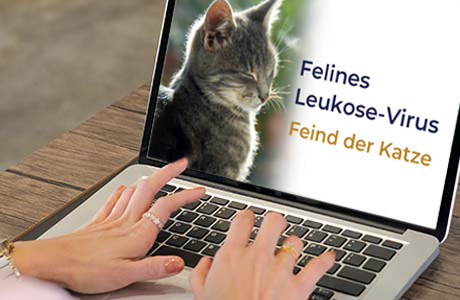
Each animal is unique!
Our experienced team will be happy to advise you in detail and free of charge on all matters relating to your pet’s health. Book your consultation appointment now:
Feline leukosis virus - enemy of the cat
August 31, 2021
Petra Remsing – veterinary practitioner
The Feline Leukemia Virus belongs to the retroviruses and is better known under the now obsolete term Feline Leukosis Virus. The severity of the disease and the course depend on the immune system of the infected cat. So what does this mean for your cat?
In addition to conventional medical therapy options, you can support your cat with naturopathic remedies. One focus here is on the medicinal mushrooms Coriolus, Agaricus blazei murrill (ABM), Reishi, Cordyceps and Shiitake.
Free information now Unlock on the topic "Felines Leukose Virus
- Recording of our webinar with animal healer Petra Friedrich

After you submit the completed form, you will be able to view the information immediately and will also receive an email with a download link.
Discovery in Scotland
The virus was discovered in 1964 by the Jarrett brothers in Scotland. Several cats had died from lymphosarcoma. During the autopsy, a connection was established between the tumor disease and the viral infection. In subsequent years, the virus was found to cause tumors and also to be responsible for many other diseases.
Transmission routes of the feline leukemia virus
Transmission occurs primarily through saliva, but also through the blood. Infection can also occur via feces, urine and mother’s milk, primarily from animal to animal: for example, when playing, sniffing each other, but also when grooming or during cat fights. The virus itself decays very quickly in air, so it is not very durable. However, it lasts a little longer in humid climates. Thus, it can also be transmitted through drinking bowls, food bowls or litter boxes.
The Feline Leukemia Virus – like the HIV virus – belongs to the retroviruses. However, it is a cat-specific virus and is not transmissible to humans or other animals. It primarily infects the defense cells, especially T-helper cells and macrophages. During virus replication, the cell’s metabolism is downregulated. As a result, this cell loses its defense function. These cells are then no longer available for the body’s defense against viruses, bacteria and cancer cells. Immune deficiency occurs.
Therefore, in animals with a weakened immune system, cellular defenses should be strengthened. We can do this, for example, with the vital mushroom Coriolus. Its polysaccharides have immunostimulatory and antitumor activity. The main active ingredients in Coriolus are PSP and PSK. This fungus therefore strengthens a weakened immune system and the immune system can then fight the viruses better.
Course of the disease can be very different
The course of the disease depends on various factors. Once from the age of the animal, but also from the immune status. In the best case, the immune system is able to fight the virus. The spread is prevented and the animals have formed antibodies accordingly. These antibodies then protect the infected animal from a renewed infection: one speaks then of Regressorkatzen. It is about 30-50% of all cats that manage to fight the virus.
If the animal fails to do so, a condition called viremia occurs. The viruses then enter the bloodstream with the monocytes and lymphocytes. These animals can then infect other animals, because they have now become virus excretors.
Simply request free information brochures now!

After you have sent the completed form, you will receive an e-mail with a download link.
Changes in the blood of the cat
The primary consequences of infection are anemia. The affected animals have too few red blood cells. As a result, they are tired and weak. The mucous membranes are pale, almost white, especially well seen on the eyes, but also on the mucous membranes of the mouth. Then there is also a lower number of platelets and possibly granulocytes.
Here you can very nicely use the vital mushroom ABM, the Agaricus blazei murrill. It stimulates blood formation in the bone marrow, has a regulating effect on the immune system and, like Coriolus, helps the immune system to eliminate viruses.

Each animal is unique!
Our experienced team will be happy to advise you in detail and free of charge on all matters relating to the health of your pet:
Other symptoms and diseases
Due to the immunodeficiency, the animals often develop additional diseases. Often secondary infections with fungi, further viruses, with bacteria but also with protozoa are possible. In secondary infections, the symptoms are usually very nonspecific and give little indication of disease with feline leukemia virus. Most animals suffer from loss of appetite, resulting in weight loss and have a poor general condition. Some are also dehydrated, that is, dehydrated.
Gastrointestinal symptoms, i.e., symptoms in the stomach and intestinal area, such as diarrhea, vomiting, and inflammation of the mucous membranes of the mouth (stomatitis), inflammation of the gums (gingivitis) are also possible. Here, no one would immediately think of a Feline Leukemia Virus infection.
Reishi for inflammation
Typical are also respiratory diseases, here primarily nasal mucosa inflammation but also pneumonia. In addition, the animals may have eye diseases, such as conjunctivitis (inflammation of the conjunctiva). Here, the Reishi is a very important mushroom, especially in an inflammatory event. Reishi has the most triterpenes in the fruiting body and spores. These triterpenes have a strong anti-inflammatory effect.
In addition, the cats can get tumor diseases. Here, the animals then develop either lymphoma or leukemia. Most of the time, these are very young animals. In tumor diseases, especially lymphoma, ABM is a very important and effective fungus. It has an anti-tumor effect and has an immunomodulating effect.
Besides ABM, Cordyceps is also an important mushroom, especially for lymphoma diseases. Its administration mainly prolongs the life of the animals. Cordyceps suppresses DNA production and also RNA synthesis in tumor cells. It contains cordycepin. This has a cytotoxic effect on leukemia cells and also inhibits their proliferation.
Feline leukemia virus can also trigger:
- Polyarthritis
- Reproductive disorders
- Neuropathies
- Paralysis symptoms
- Horner syndrome
The symptoms and therapeutic approaches of the feline leukemia virus can therefore be quite diverse.
We therefore recommend: seek advice from a therapist. Our animal mycotherapists are happy to receive your call and will be happy to advise you free of charge.
For mushroom powders there are many suppliers
You will find trustworthy suppliers with controlled organic cultivation in Germany, but unfortunately also less recommendable importers of cheap goods. Read what is important when buying.
DO YOU HAVE ANY QUESTIONS?
We will gladly take time for you. In our free consultation, we will answer all your questions about your pet’s health individually and personally.
